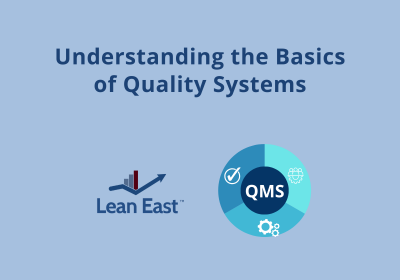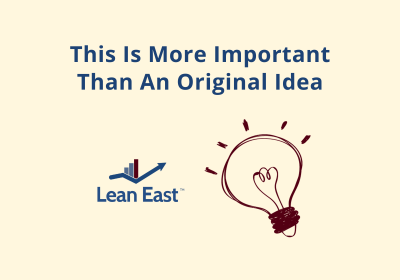Lean East brings out the best in organizations by bringing out the best in their people. We train employees process improvement and problem-solving methods based on Lean principles first developed by the Japanese company Toyota. This means many Lean concepts are based on Toyota principles described by Japanese words without English counterparts. This post will define many of the common Japanese words in Lean – like kaizen – and explain why they are important.
Note that many Lean East clients may not have learned these words in our Introductory Lean training or even our Lean Six Sigma Green Belt training program. We tend to avoid using words that make Lean seem harder to understand than it really is. Our hope is for you to use this page as a place to understand a new Japanese word or concept quickly.
Here are many of the common Japanese words used in Lean thinking:
Kaizen
Kaizen translates to “continuous improvement” and is the core philosophy of Lean. It encourages everyone in the organization to constantly look for ways to improve processes, eliminate waste, and create more value for the customer. Our Personal Kaizen community focuses on self-improvement concepts – click here to sign-up.
Muda
Muda translates to “waste” and refers to any activity that does not add value to the product or service for the customer. Lean focuses on eliminating muda throughout the production process. Lean East has our clients examine the process and identify eight wastes of Lean, shown below.

Mura
Mura translates to “unevenness” and refers to inconsistencies in production flow. Factors such as uneven demand, breakdowns, or lack of materials can cause Mura. Lean strives to create a smooth and consistent production flow. The concept and methods of Six Sigma focus on understanding, controlling, and also eliminating the causes of process variation.
Muri
Muri translates to “overburden” and refers to putting too much strain on people or equipment. This can lead to defects, safety hazards, and employee burnout. Lean emphasizes creating a sustainable workload for both people and machines.
Note how similar the Japanese words muda, mura, and muri are. These three concepts are related; issues with any one of the three will lead to issues with the others. For example, unevenness often leads to overburdening and also results in defects from rushing. The defects create more unevenness and overburden later.

Kanban
Kanban translates to “signboard” and refers to a pull system used in Lean to manage inventory. These signals are used to authorize the production of more parts only when they are needed downstream in the process. This helps to reduce waste while improving efficiency. Kanban methods have been adopted by Agile software development methodologies.
Poka-Yoke
Poka-yoke is a Japanese phrase that translates to “mistake-proofing” and refers to techniques used to prevent errors from occurring in the first place. These devices can be physical mechanisms or procedures that make it impossible or difficult to do something incorrectly.
5S
5S is a Japanese methodology for organizing and maintaining a clean, efficient, and safe work environment. The five S’s stand for Seiri (Sort), Seiton (Set in Place), Seiso (Shine), Seiketsu (Standardize), and Shitsuke (Sustain). This methodology is used in many organizations to reduce waste and improve efficiency by creating a well-organized and clean work environment. The five elements of 5S work together to create a work environment that is both visually appealing and functional. This helps to increase productivity and improve overall quality.

Andon
Andon translates to “lamp” or “signal” and refers to a visual signaling system used in Lean to alert workers to problems on the production line. This signal helps to identify and address issues quickly, preventing them from disrupting production.
Toyota emphasizes “respect for people” and gives production workers the ability to note a problem by shutting down the production line. The purpose of Andon is to provide real-time feedback on the status of the production process and to allow for quick resolution of problems. This helps to ensure a smooth and efficient flow of work. It also minimizes the impact of problems on the overall production process.
Gemba
Gemba is a Japanese term that refers to the actual place where work is performed. By visiting the Gemba and observing work processes, it is possible to identify opportunities for improvement and implement changes that will make the work more efficient and effective.
The idea behind Gemba is to go to the source of a problem and observe it directly to gain a deeper understanding of the situation and to find the most effective solution.
Jidoka
Jidoka translates to “autonomation” and refers to designing machines and processes to stop automatically when a problem occurs. By empowering workers to identify and solve problems themselves, Jidoka prevents defects and improves quality. The recent growth of artificial intelligence will enable smarter machines in the future.
Heijunka
Heijunka is a Japanese term for production leveling. This involves analyzing the demand for a product and adjusting the production process accordingly so that the same amount of work is performed daily. Heijunka helps to minimize the impact of fluctuations in demand and ensures a stable and predictable production process.
Hoshin Kanri
Hoshin Kanri is a Japanese term that refers to strategic planning. The goal of Hoshin Kanri is to align the activities of an organization with its overall strategy. This is to ensure that everyone is working towards the same goals.
Hoshin Kanri involves setting long-term goals and objectives and then breaking them down into smaller, more manageable steps. This process helps to ensure that everyone in the organization is working towards the same goals and that the organization’s activities are aligned with its overall strategy. Ask us to share an X-Matrix example with you!

Kaikaku
Kaikaku is a Japanese term that means “radical change.” Unlike continuous improvement, Kaikaku is a more drastic change that involves breaking down traditional working methods and completely rethinking and redesigning processes. Kaikaku is implemented when small incremental improvements are no longer enough to meet the changing demands of a business and is often used to achieve significant cost savings, increase efficiency, and improve quality.
Yokoten
Yokoten is a Japanese term that refers to the practice of spreading and sharing best practices and improvements across different parts of an organization. The goal of Yokoten is to leverage the collective knowledge and experience of the entire organization to drive improvement and achieve business objectives. By utilizing Yokoten, companies can gain a competitive advantage, as they can learn from each employee’s successes and failures. As a result, they can continuously improve their own processes.
Summary
This is just an introduction to some of the important Japanese words in Lean that we may share with clients and others. As stated earlier, we tend to minimize using Japanese words when English alternatives make the point.
Please leave your comments and questions below. Let us know in the comments if we missed sharing a Japanese word that describes an important Lean concept.




